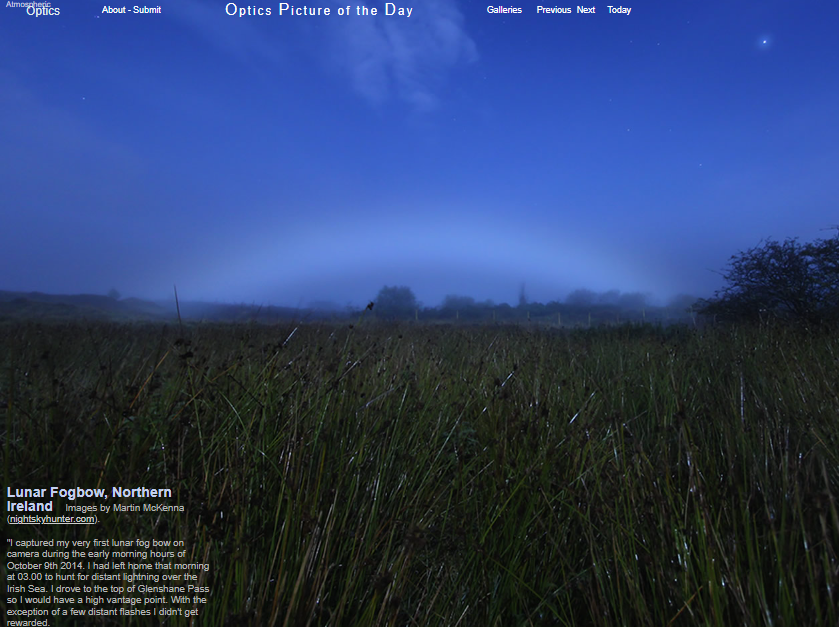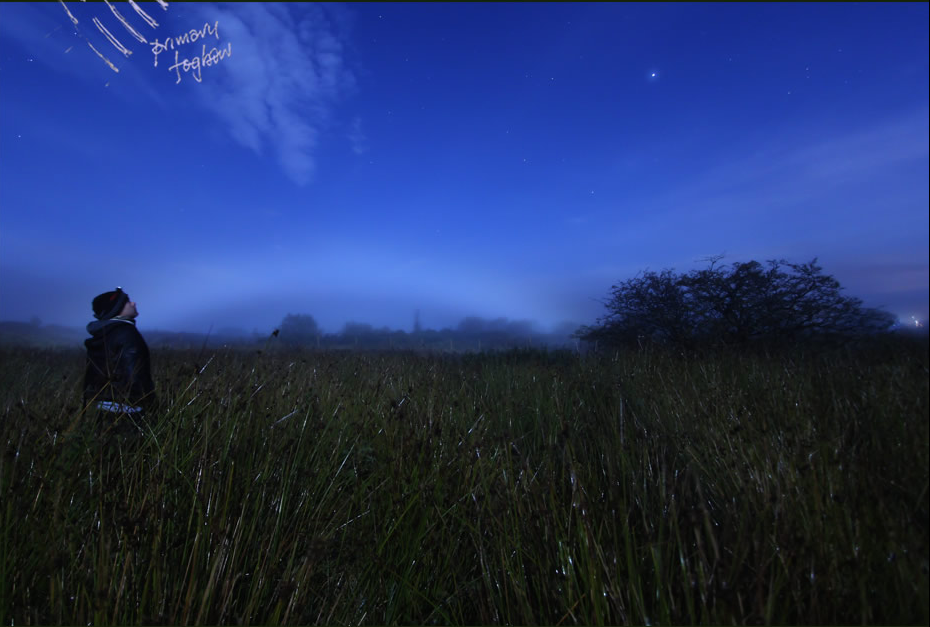Lunar Fogbow, Northern Ireland - OPOD
Lunar Fogbow: A Rare Atmospheric Phenomenon in Northern Ireland
Lunar fogbows are a mesmerizing and rare atmospheric phenomenon that occurs when fog or mist is illuminated by the bright light of the moon. The ethereal display resembles a ghostly white bow, almost devoid of color. Recently, on the early morning of October 9th, 2014, Martin McKenna, a passionate photographer and sky watcher, had the opportunity to capture this elusive spectacle in Northern Ireland.
McKenna embarked on his nocturnal adventure with the intention of capturing distant lightning over the Irish Sea. Although he didn't find what he was initially searching for, he was rewarded with a breathtaking sight. As he stood atop Glenshane Pass, he noticed a strange apparition at the bottom of the field. It appeared as a glowing heavenly form, brighter than anything else in the area. It was then that McKenna realized he was witnessing a rare lunar fogbow manifesting right before his eyes.
Between 4:00 and 5:00 AM, McKenna was treated to an awe-inspiring display of nature's artistry. The ghostly white bow gracefully adorned the field, with the stars and the planet Jupiter shining brightly in the background. With the naked eye, he could discern an orange crown adorning the upper section of the bow. The serenity and beauty of this moment were captured by McKenna's camera lens, allowing him to share this extraordinary experience with others.
Photographing a lunar fogbow can be quite challenging due to its rarity and specific conditions required for its formation. The presence of fog or mist, combined with bright moonlight shining through it, creates the perfect canvas for this ethereal phenomenon. Additionally, a reasonably dark sky enhances the visibility of the lunar fogbow. These factors significantly reduce the opportunities to witness and photograph this spectacle.
To capture the lunar fogbow in all its glory, McKenna used a 10mm lens on his Canon 600D camera, setting the ISO to 800 and the exposure time between 20 and 28 seconds. Despite the challenges of maneuvering through dew-soaked grass, which at some points reached chest height, McKenna managed to position himself in the frame, creating a memorable shot with the lunar fogbow as his backdrop.
Throughout his years of sky watching and photography, McKenna had encountered numerous moonbows but had only witnessed three true lunar fogbows prior to this occasion. The rarity of these occurrences makes them all the more captivating. The experience of observing this celestial phenomenon in the middle of nowhere, high on a mountain, left McKenna delighted and craving for more such encounters.
Lunar fogbows, similar to their cousins, lunar rainbows, are formed through a process known as refraction and diffraction. When incoming light waves enter a droplet of fog or mist, they undergo refraction, bending as they pass through. Some of these waves are reflected by the opposite side of the droplet before refracting once again as they exit. This complex interplay of refraction and reflection results in the overlapping and spreading (diffraction) of multiple waves, ultimately forming a broad and diffuse bow.
In conclusion, the sighting and photography of a lunar fogbow in Northern Ireland provided Martin McKenna with an unforgettable experience. The combination of fog or mist, bright moonlight, and a reasonably dark sky creates the ideal conditions for this rare phenomenon to occur. While capturing a lunar fogbow can be challenging, the reward is well worth the effort. McKenna's photographs serve as a testament to the captivating beauty of nature and remind us of the wonders that lie above us in the night sky.

Lunar Fogbow, Northern Ireland Images by Martin McKenna (nightskyhunter.com).
"I captured my very first lunar fog bow on camera during the early morning hours of October 9th 2014. I had left home that morning at 03.00 to hunt for distant lightning over the Irish Sea. I drove to the top of Glenshane Pass so I would have a high vantage point. With the exception of a few distant flashes I didn't get rewarded.
The night was beautiful though with a brilliant waning full moon, stars and fog for company, then just as I was thinking of calling it a night I saw a strange apparition at the bottom of the field in which I stood, it looked like a glowing heavenly form which was brighter than everything else in the area, then I realized what it was - a rare lunar fog bow in the process of manifesting in front of me.
Between 04.00 and 05.00 I was treated to this most beautiful display with the ghostly white bow in the field with the stars and planet Jupiter to the upper right. With the naked eye I could see an orange crown to the upper section of the bow,
I took these images with a 10mm lens using my Canon 600D at ISO800 between 20 and 28 sec's. I just had to jump into the grass to get a shot of me with the this prize catch despite getting soaked with dew in the grass - which in places was up to chest height. I have photographed many moonbows over the years and have only ever observed three true lunar fog bows and on each occasion I never had a camera - until now. I had such a great experience high on the mountain in the middle of nowhere watching this wonderful phenomena and I was delighted to have finally ticked it off my list, I'm now hooked and will be on the hunt for more."
All images ©Martin McKenna, shown with permission

Fog, or mist, and bright moonlight shining clearly through it are essential. Plus a reasonably dark sky. That reduces the opportunities to see a lunar fogbow considerably. Their cousins, lunar rainbows, are similarly elusive.
Incoming light waves enter a droplet and are refracted. Some are reflected by the opposite side of the drop. They refract once again as they leave. The multiple waves overlap, interact and spread - diffract - while all this happens. The outcome is a broad and diffuse bow almost devoid of colour.

Note: this article has been automatically converted from the old site and may not appear as intended. You can find the original article here.
Reference Atmospheric Optics
If you use any of the definitions, information, or data presented on Atmospheric Optics, please copy the link or reference below to properly credit us as the reference source. Thank you!
-
<a href="https://atoptics.co.uk/blog/lunar-fogbow-northern-ireland-opod/">Lunar Fogbow, Northern Ireland - OPOD</a>
-
"Lunar Fogbow, Northern Ireland - OPOD". Atmospheric Optics. Accessed on April 20, 2024. https://atoptics.co.uk/blog/lunar-fogbow-northern-ireland-opod/.
-
"Lunar Fogbow, Northern Ireland - OPOD". Atmospheric Optics, https://atoptics.co.uk/blog/lunar-fogbow-northern-ireland-opod/. Accessed 20 April, 2024
-
Lunar Fogbow, Northern Ireland - OPOD. Atmospheric Optics. Retrieved from https://atoptics.co.uk/blog/lunar-fogbow-northern-ireland-opod/.